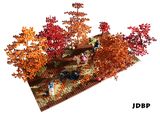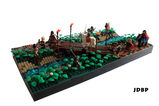 
       
|
Out with the new Vehicle vs Vehicle Medieval Husbandry Castle Building The Merry Band The Best Intentions Custom Castle Figure Castle Siege Miscellaneous - Small Creation Miscellaneous - Large Creation Fairy Tale Castle
Entries submitted by peggyjdb

|
Bannockburn
1314AD, 24th June, Bannockburn, Near Stirling, Scotland. Edward II decides leads an army to attack the Scottish following their besieging of the English garrison at Stirling castle the year before.
The 'War of the North' (Wars of Scottish Independence) had been ongoing since 1296AD, begun when Edward I had invaded Scotland to enforce his claim of overlordship on John Balliol, King of Scotland. During Edward I's reign the war had been going the way of the English, following his death though his son's position became more difficult. When Stirling Castle was besieged an agreement was made that if the castle was not relieved by the English by summer it would be surrendered to the Scots. Edward II was unable to ignore the challenge and raised the largest army that had yet been seen on English soil.
The army crossed the boarder on 17 June 1314 and approached Stirling Castle via the crossing over the Bannock burn. Unlike most medieval battles it took place over two days. Battles at this time were dominated by the mass charge of knights. The Scots at this time came up with a solution. They developed an arrangement called a 'schiltrom', which was a group of a few dozen men with huge long pikes, over 5m long. These were radiated outwards with the pikes dug into the ground whilst the men held it. The English knights charging the schltrom were impalled on these spikes. You can read more detail about the battle here:
http://en.wikipedia.org/wiki/Battle_of_Bannockburn
The English leaders from their defeat firstly mounted knights en masse could not always be relied upon to over come properly organized and well disciplined infantry unless they had support of archers. Secondly that the their archers had won the firefight with the Scottish archers by virtue of the weight of fire. Thirdly that the choice of ground could be a deciding factor in the outcome of a battle. Fourthly that the ground could be improved with obstacles.
https://www.flickr.com/photos/peggyjdb/sets/72157649240893128/
Submitted by: peggyjdb
|
|

|
Come a cropper
1315 - 1317AD, Europe, including Britain. A farmer struggles on ploughing his flooded field, his wife follows after him planting seed that will hopeful will be harvest this summer. Their youngest son meanwhile attempts to keep the crows away. Meanwhile their neighbours field is left to fallow - not everybody survives this crises.
Following the Scottish victory at Bannockburn in 1314AD, Edward II's and England's difficult times continue with torrential rains in late 1314AD, followed by a very cold winter and more heavy rain in the spring of 1315AD. The result to begin with is the death of many sheep and cattle. Over the next six years bad harvests continue with more inclement weather. The Scots are also hit, but as the victors they raid northern England, beginning with attacks on Carlisle and Berwick - then reaching further south into Yorkshire and Lancashire, even threatening York. The famine does little to Edward's popularity.
On a continental perspective the famine extends from south Russia to Italy, causing millions of deaths. Europe did not fully recover until 1322 and the period was marked by extreme levels of crime, disease, mass death, and even cannibalism and infanticide.
https://www.flickr.com/photos/peggyjdb/15940548389/
Submitted by: peggyjdb
|
|

|
No 25. Edward III
Reigned 1327AD - 1377AD
At the age of fourteen Edward III came to the throne following the invasion of his father's (Edward II) Kingdom by none other than his mother Isabella (wife of his father!) and Roger Mortimer. His father's reign had been a particularly bad time for England but the nation was transformed under Edward III.
Three years after his reign began he led a successful coup against Roger Mortimer, who in practice was ruler of the country. Afterwards he had a successful campaign in Scotland he then declared himself rightful heir to the French throne in 1337. This claim was denied due to the Salic law (A Frankish law which was used in the governance of France). And so began a long war with France (later to become know as the Hundred Years' War. The beginning of the war saw set backs for England but then it went exceptionally with major victories at Crécy and Poitiers. This led to the highly favourable Treaty of Brétigny. To show his right as King of France he altered the Royal arms of England in 1340 by quartering his paternal Arms of Plantagenet (The Three Lions) with the fleurs de lys, the Royal Arms of France
He has been called the 'Father of English Commerce' due to his encouragement of trade at home (England and Wales) and abroad. During his reign parliament gradually developed into a bicameral institution, composed of a House of Lords and a House of Commons.
In his later later years poor health and inactivity led to some international failure and domestic strife, though overall his reign is seen as having been a good one for the nation of England
http://www.brickshelf.com/cgi-bin/gallery.cgi?f=551771
Submitted by: peggyjdb
|
|

|
No.24 Edward II
Reigned 1307AD - 1327AD
Possible best known for leading England in its defeat at Bannockburn by the Scottish and his friendship with Piers Gaveston.
Edwards relationship with Piers Gaveston has left much debate as to its nature, both in live and death. During his reign the Bishop of Winchester is claimed to have stated that Edward was a
https://www.flickr.com/photos/peggyjdb/15737840550/
Submitted by: peggyjdb
|
|

|
No.31 Edwatrd V
Reigned 9 April 1483AD – 26 June 1483AD
Known for mysterious disappearance in the tower with his brother in the tower at the hands of his uncle.
At the age of 12 his father, Edward IV, died suddenly. The will of the dead king nominated his brother Richard as Protector during his son's minority. At the time of Edward IV's death his son had been in the west of England and his brother in the north. They met outside London and 19th May 1483AD Edward V took up residency in the Tower of London, along with his brother Richard. Richard (III) delayed the coronation of the new king. Meanwhile a preacher claimed the marriage of Edward IV and Elizabeth Woodville to be illegitimate, thereby removing Edward V's right to be king.
Further twists resulted in Richard (III) being declared the legitimate king. Edward V and his brother Richard were seen less and less in public until they were seen no more. It is still unknown what happended to them, thouhg it is largely suspected that they were murdered by the order of their uncle, Richard III
https://www.flickr.com/photos/peggyjdb/15941217987/
Submitted by: peggyjdb
|
|

|
to make a King Laugh
1318AD, Autumn time, Wolmer Forest. King Edward II rewards Morris, one of his kitchen staff for making him laugh.
Haven gone out for a hunt one of the Kings kitchen staff, Morris, keeps falling from his horse. The numerous accidents make the King laugh and once the hunt is over he pays Morris twenty shillings - the equivalent of a years salary. Being a meticulous record keeper the King notes the payment to Morris in his private expenses which end up in the possession of a Thomas Astle an English antiquary and palaeographer (22 December 1735 – 1 December 1803).
https://www.flickr.com/photos/peggyjdb/16126628245/
Submitted by: peggyjdb
|
|

|
We're under attack
1326AD, 19th January near Rearsby, Leicestershire. Sir Rodger Bellere is attacked by the Folville Gang
Sir Rodger Bellere is a local nobleman, possesing nine manors and founded the chantry at Kirby Bellars. He also happens to be a baron of the exchequereand is protected by none other than Hugh, Lord Dispenser a favourite of King Edward II. Amongst his enemies are the Folville brothers Esutace, Rodger and Walter (they also have another four brothers who do not join the gang) who together with fellow local landowners Roger la Zouche and Robert Halewell form a gang. They attack Sir Rodger Bellere on the road between Melton Mowbray and Leicester, near Rearsby and kill him.
Following the attack the gang flee the country and are declared outlaws. Later on in the same year they are in luck as King Edward II is deposed of and put an end to Hugh Dispenser. During the turbulent political years following the Folville gang remains active before leaving there life of crime and joining Edward III's Military expedition in France - one of, Eustace, even ends up being knighted.
As for the place of Sir Rodger Bellere's murder this is understood to be marked by the so-called Folville Cross, a 1 m (3 ft 3 in) high fragment of an ancient crucifix.
https://www.flickr.com/photos/peggyjdb/sets/72157649883596246
Submitted by: peggyjdb
|
|
|
|
|










